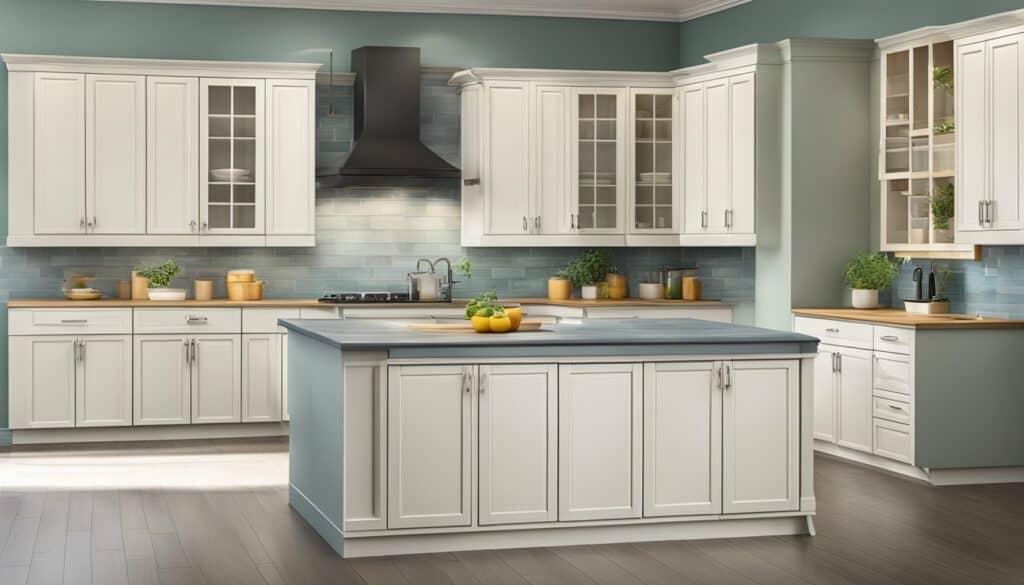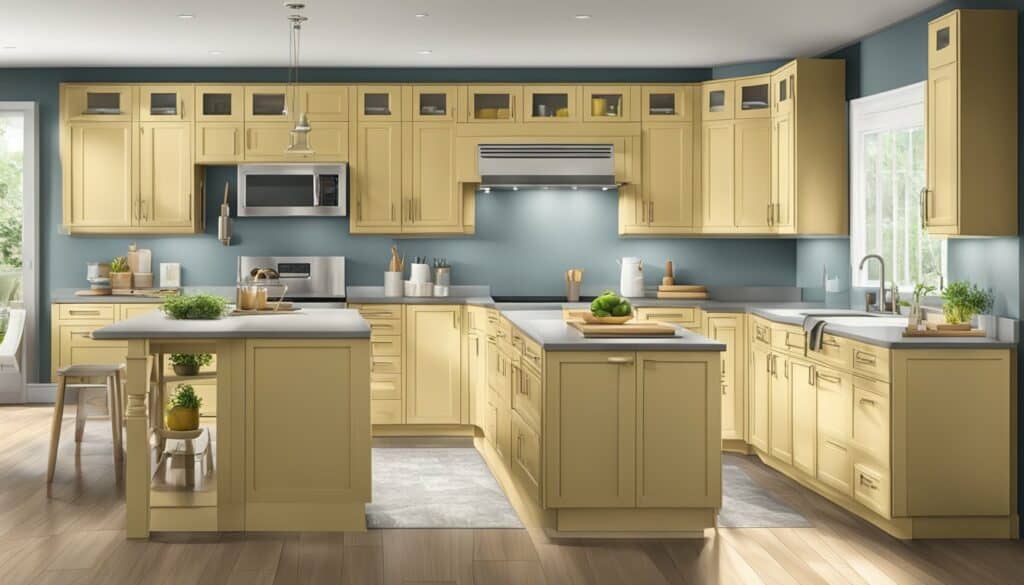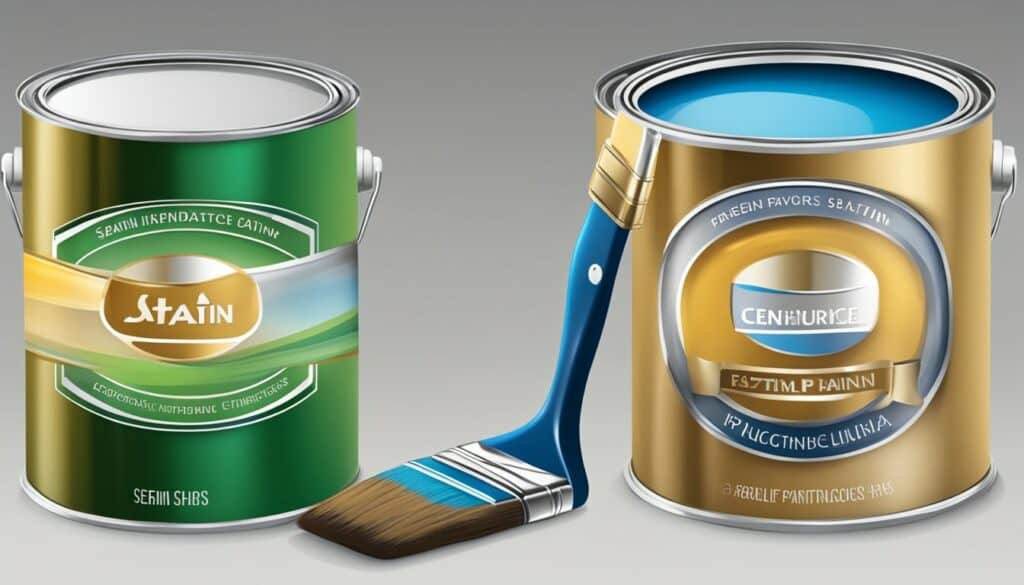Are you considering a kitchen renovation and wondering what type of finish to choose for your cabinets? Satin and semigloss are two popular options that can completely change the look and feel of your kitchen.
Satin finishes are known for their stain resistance, while semigloss can withstand moisture in the air more easily.

A satin cabinet finish is a smooth, low-sheen finish that is very popular in today’s kitchens. It has a softer look than a semigloss or high-gloss finish and is very easy to clean. Satin finishes are often used on kitchen cabinets, as well as on bathroom vanities and other woodwork in the home.
When it comes to choosing between satin and semigloss finishes for your kitchen cabinets, it’s important to consider your personal style and maintenance preferences.
While satin finishes are great for hiding imperfections and providing a soft, subtle look, semi-gloss finishes offer more durability and are easier to clean.
Keep reading to learn more about the pros and cons of each finish and which one might be the best fit for your kitchen renovation.
Understanding Kitchen Cabinets

When it comes to renovating your kitchen, choosing the right finish for your kitchen cabinets is crucial. It can completely change the look and feel of the room. Satin and semi-gloss are two popular finishes for kitchen cabinets.
Satin finish is a smooth, low-sheen finish that is very popular in today’s kitchens. It has a softer look than a semi-gloss or high-gloss finish and is very easy to clean.
Satin finishes are often used on kitchen cabinets, as well as on bathroom vanities and other woodwork in the home. Satin finishes are ideal because of the stain resistance, making it perfect for kitchens where spills and stains are common.
Semi-gloss finish sits somewhere between a satin and glossy finish. This means it is shinier than satin, but not as shiny as a glossy finish. While a shiny semi-gloss finish looks good to the eye, it slightly obscures the base color used.
Semi-gloss finishes are more durable and can withstand moisture in the air more easily, making it a good option for kitchens with high humidity levels.
When choosing between satin and semi-gloss for your kitchen cabinets, consider the overall look and feel you are trying to achieve. Satin finish can give your kitchen a warm and inviting feel, while semi-gloss can give it a more modern and sleek look.
Additionally, consider the level of maintenance you are willing to commit to. Satin finishes are easier to clean, while semi-gloss finishes require more maintenance to keep them looking their best.
In conclusion, understanding the different finishes available for kitchen cabinets can help you make an informed decision when renovating your kitchen.
Satin and semi-gloss are both great options, and the choice ultimately comes down to personal preference and the look you are trying to achieve.
Exploring Paint Types

When it comes to painting your kitchen cabinets, choosing the right type of paint is essential. You want a finish that not only looks great but can also withstand the wear and tear of everyday use. Two popular options for kitchen cabinets are satin and semi-gloss paint. Here’s what you need to know about each type:
Satin Paint
Satin paint has a smooth, low-sheen finish that is easy to clean and maintain. It’s a great choice for kitchen cabinets because it offers good stain resistance and can hide minor imperfections. Satin paint is also less reflective than semi-gloss, which can be a plus if you want to tone down the shine in your kitchen.
If you choose to use satin paint for your kitchen cabinets, be aware that it may not be as durable as semi-gloss. Satin finishes are more prone to showing scratches and scuffs, so you may need to touch up your cabinets more often.
Semi-Gloss Paint
Semi-gloss paint has a shiny, reflective finish that is highly durable and resistant to moisture. It’s a good choice for high-traffic areas like kitchens because it can stand up to frequent cleaning and use. Semi-gloss paint is also great for highlighting architectural details on your cabinets, like molding or trim.
One downside of semi-gloss paint is that it can show imperfections more easily than satin. If your cabinets have a lot of dings or scratches, a semi-gloss finish may not be the best choice. Additionally, semi-gloss paint can be more difficult to touch up than satin because the shiny finish can be hard to match.
Oil-Based Paint
Another factor to consider when choosing paint for your kitchen cabinets is the type of paint base. Oil-based paint is known for its durability and resistance to wear and tear. It’s a great option if you want a finish that will last for years without needing to be repainted.
However, oil-based paint can be more difficult to work with than water-based paint. It has a strong odor and requires solvents for cleanup, which can be messy and time-consuming. Additionally, oil-based paint takes longer to dry than water-based paint, which can be frustrating if you’re in a hurry to finish your project.
When it comes to painting your kitchen cabinets, there are a lot of factors to consider. Satin and semi-gloss paint are both great options, depending on your needs and preferences. And don’t forget to think about the type of paint base you want to use, whether it’s oil-based or water-based. With a little research and planning, you can create a beautiful, durable finish for your cabinets that will last for years to come.
Satin or semi-gloss for kitchen cabinets? Let VIP House Services help you decide. And with a free estimate, you can start planning your kitchen renovation project without any upfront costs. Don’t settle for less than the best – let VIP House Services bring your vision to life.
